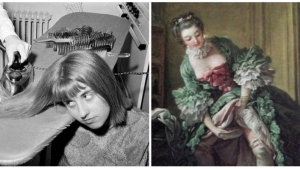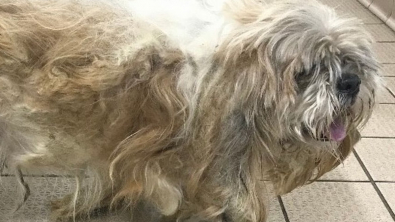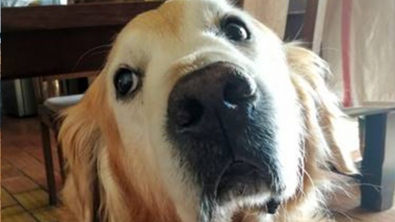9 gross health and beauty practices that fortunately no longer exist
Back in the day people didn't bother washing themselves that much and lack of hygiene wasn't an issue because everyone was, for want of a better word, smelly! If we went back in time, we'd find a world that was dangerously unhygienic, which partly explains why life expectancy was so much shorter...
Here are 9 gross health and beauty practices that our ancestors took for granted

1. Chamber pots

© Francois Boucher © un-certain-regard
Before toilets appeared people would pee or poo into a chamber pot or butt-shaped bowls that were fitted onto chairs. This meant they could 'do their business' wherever they liked - even during a meals!
The earliest latrines were simply circles of sand surrounded by stones. The ancient Romans improved matters by building the first sewers and public restrooms where people could catch up on the latest gossip whilst relieving themselves.
The Middle Ages saw a slump in hygiene practices and people started to use copper receptacles that would then be emptied out of the window. Only the rich could afford what we now know as chamber pots - large porcelain bowls that have since become a collectors' item - although beware, as some dodgy antique dealers will tell you that they're giant gravy boats!
Fortunately the Renaissance saw the construction of sewers based on the Romans' system and, finally, in 1590 the first toilet was invented.
2. Contraception

When Christopher Columbus returned to Europe in 1494, he brought back with him a nasty dose of syphilis and it only took a few years before this contagious disease had spread across Europe. It wasn't until the 17th Century that the first condoms appeared. True, certain prototypes did already exist, but some people claim that it was an associate of King Charles II, the Earl of Condom, who came up with the practical design we find today - a theory that has since been dismissed by historians.
3. Abortion
Abortions were extremely painful, highly dangerous procedures where women would use sharp objects including knitting needles, clothes hangers or skewers to remove their fetus. Some 'midwives' would give their patients toxic potions that would cause the woman to miscarry. These potions tended to be made from iodine, glycerin or quicksilver (a Chinese favorite) and they were usually directly injected into the uterus. Although these methods worked, they often led to severe complications or even death.
4. Shaving

As far as we know, men have always shaved - not so much for aesthetic reasons, but to get rid of parasites that would nest in their beards and moustaches. Over the centuries, men would use a range of 'instruments' from shells to knives, mud (to soften skin), wax (on younger men), burning hot liquids and even swords, axes and sabers! Professional barbers would usually do the deed, in order to prevent slit throats and other potentially fatal accidents.
5. Feminine hygiene
Archaeologists have found items made from papyrus-covered wood that resemble tampons on ancient Egypt sites. During Roman times, women used cotton tampons, whilst in Medieval Europe, noblewomen made pads that they would attach to their belt or skirt. Up until the 20th Century, these pads would be washed and re-used, but during the First World War, nurses came up with idea of using absorbable, disposable, medical pads. These led to the manufacture of the hygienic products we find today.
5. Dental hygiene

The first toothbrushes had a double-sided head - one side had wooden 'teeth' to brush and the other a tooth pick to clean between the teeth. Other teeth-cleaning methods included rubbing chalk or charcoal onto teeth before rinsing. In Europe, prudishness meant people didn't often brush their teeth and in some circles it was considered to be an unsavory practice. That said, one 17th Century book described cavities as being caused by 'teeth worms', which suddenly made dental hygiene acceptable, and by 1780 the first mass-manufactured toothbrushes hit the shelves. Synthetic bristle toothbrushes appeared during the 20th Century meaning that bacteria couldn't easily accumulate and dental hygiene became common practice.
6. Deodorants

Deodorants were first used in Egypt and the Middle East. They were made from blends of essential oils and applied to the armpits. In Asia, salt was a popular ingredient, whilst in Europe deodorizing perfumes didn't appear until the 16th Century. The first 'modern day' deodorant was made in the US in 1880, but it took until 1930 for roll-ons to appear. Five years' later ARRID began to manufacture the first antiperspirant.
7. Hair straighteners
Straightening hair isn't a modern concept, but straightening irons are! In the past, women would straighten their locks by wrapping bandages around their head overnight or by simply using an iron!
8. Diapers

In ancient times, diapers were made from animal skins padded with dry grass, moss, straw or even ash to soak up pee and poo. It was Marion Donovan, an inventor and former director at Vogue, who developed the first waterproof disposable diaper. She came up with this practical solution as her long working hours meant she needed to save time when it came to changing her baby girl's diaper. At first people mocked the idea, but Donovan had the last laugh when she sold her patent for $1 million! The first Pampers disposable diapers went on sale in 1961!
9. Skincare
Here's how women in 1940 kept their complexions youthfully fresh - they covered their faces with ice cubes to firm up their skin and boost circulation!

By Straker Julia
Writer
Passionate about writing, I write articles on the subjects that I love. Creativity and Animals themes are my favorites!


